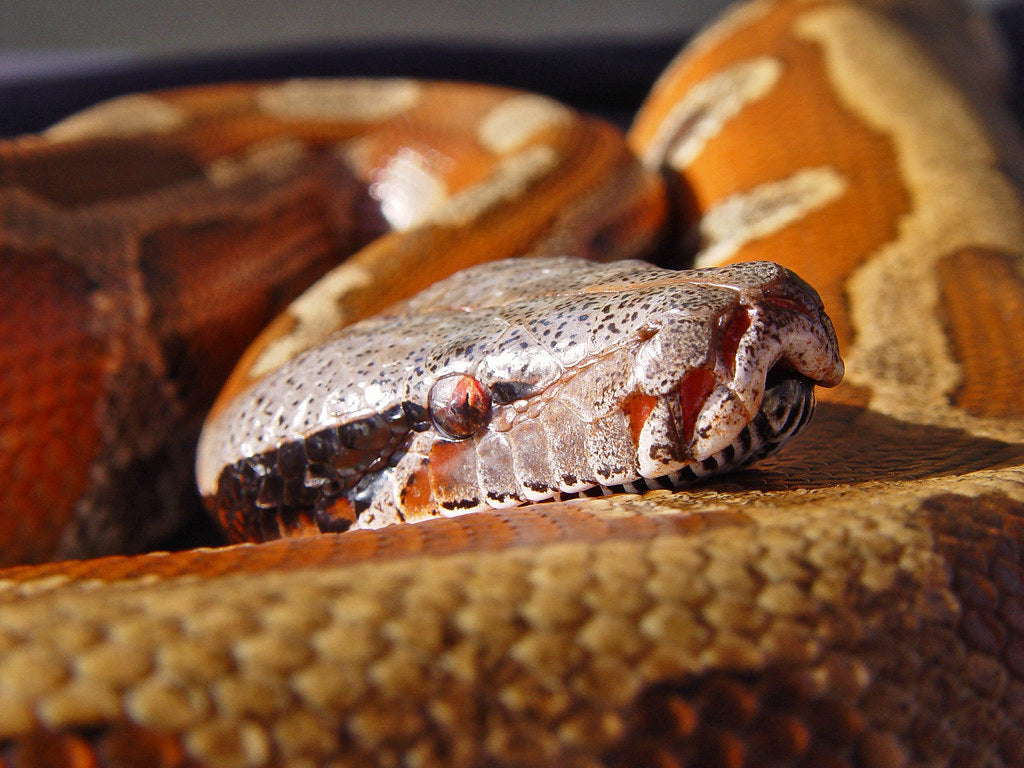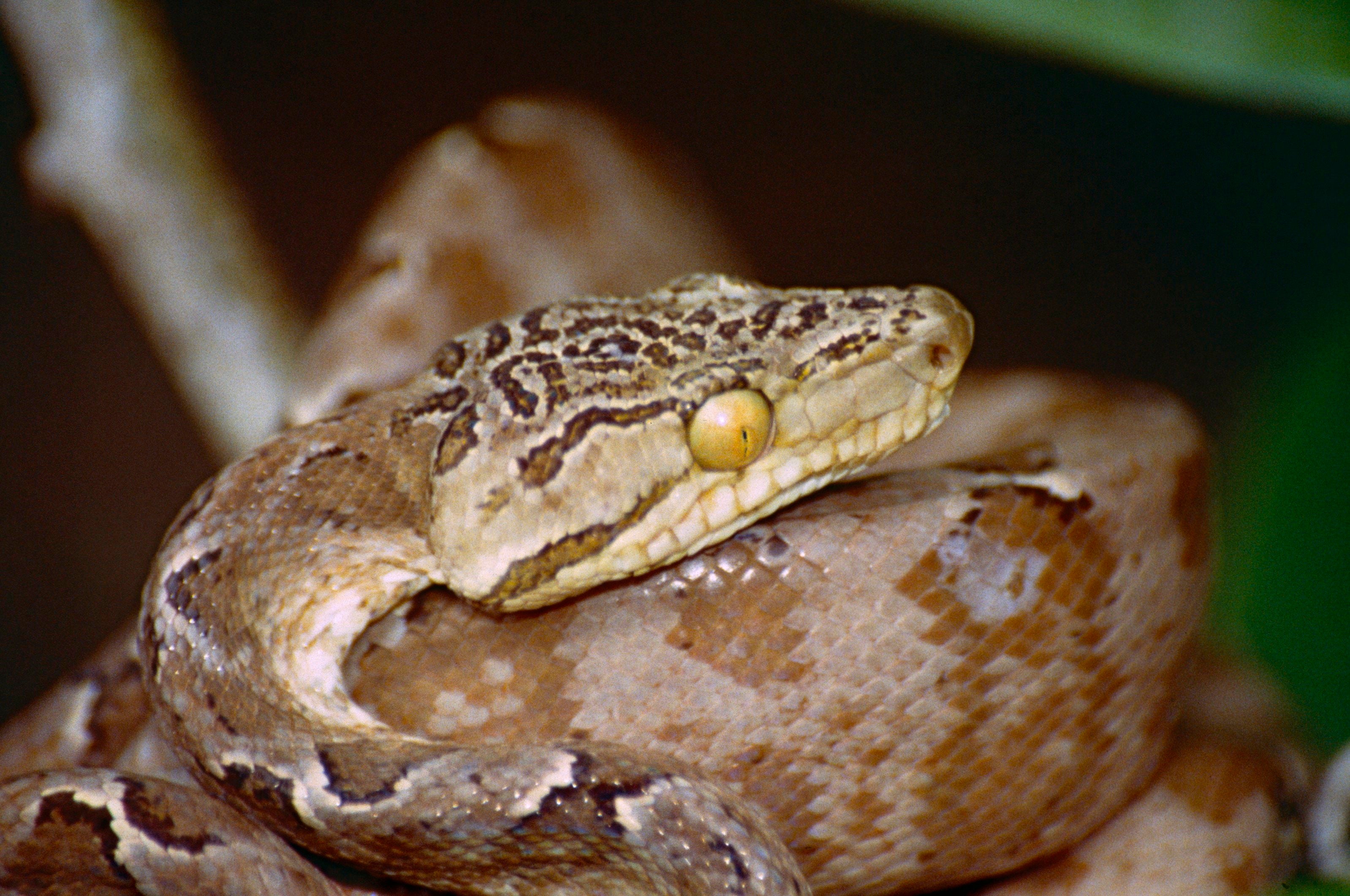Blood pythons and short-tailed pythons are a group of medium-sized, terrestrial, crepuscular snakes in the Python genus: P. breitensteini, P. brongersmai, P. curtis, and P. kyaiktiyo. All but P. kyaiktiyo are readily found in the pet trade. They are native to southeast Asia, and prefer a tropical forest habitat.
Blood/short-tailed pythons vary between 3-6’ in length, with females being significantly larger than males. They have very thick bodies, slender rectangular heads, and vertical pupils. Color varies based on species, but they usually have a blotched pattern in varying combinations of red, orange, yellow, brown, and cream. The head usually has a thin dark stripe between the eyes and broad dark stripes on the sides. Sumatran blood pythons (P. curtus) are commonly referred to as “black bloods” because of their uniquely dark coloring.
Although blood and short-tailed pythons have something of a fearsome reputation, they can make great pets for advanced-level keepers who know how to care for them properly. With good care, these snakes can live at least 20 years.
For the purposes of this care sheet, all three major species will be collectively referred to as “blood pythons.”
How much space do blood pythons need?
Like ball pythons, blood pythons have gained a reputation as being very sedentary snakes, and therefore there are plenty of misconceptions that providing a large enclosure is unnecessary and possibly even harmful. However, blood pythons still need an enclosure that allows them to stretch out fully, thermoregulate, and explore as desired.
The minimum for appropriately keeping one adult blood python is 4’L x 2’W x 2’H, but experienced keepers have observed that larger (such as 6’ x 2’ x 2’) is beneficial and gets fully utilized by the snake. For the snake’s comfort, this enclosure should be front-opening and have opaque sides.
Cohabitation (keeping multiple blood pythons in one enclosure) is not recommended, as this is not a social species.
Do blood pythons need UVB?
Contrary to popular myth, blood pythons are not stressed by the presence of light when they have opportunities to escape it as needed. Regarding UVB lighting, they are capable of surviving without it, but it’s still best practice to provide UVB lighting for optimal health and wellbeing. UVB gives reptiles all of the vitamin D that their bodies need, stimulates better appetite and activity, and generally allows them to be healthier than they would be without.
Blood pythons do best with low-strength UVB as part of their enclosure. Here are the best UVB bulbs for blood pythons housed in a 48” x 24” x 24” enclosure:
- Zoo Med Reptisun T5 HO 5.0, 22”
- Arcadia Forest 6%, 22”
The UVB bulb should be housed in a reflective fixture such as Arcadia or Vivarium Electronics, and placed close to the heat lamp, about 9-11” above the snake’s back if over mesh, and 12-14” above the snake’s back if not. Make sure that the fixture your UVB bulb is in does not have a clear plastic or glass bulb cover, as these materials block UVB. UVB lighting also decays over time, so make sure to replace your bulb every 12 months to maintain its performance.
Due to their equatorial origin, blood pythons should receive roughly 12 hours of light year-round.
What basking temperatures do blood pythons need?
Like other reptiles, blood pythons are ectotherms, which means that they need a temperature gradient in their enclosure to help them regulate their metabolism and stay healthy.
Blood pythons like to stay relatively cool. They should have a basking air temperature between 84-88°F, down to 75-78°F on the cool side. It is very important that they have ready access to a cool area in the enclosure, or else they will get stressed. Temperatures should be measured with digital probe thermometers.
Provide heat for your blood python by imitating the sun with a few moderate-wattage heat bulbs clustered on one side of the enclosure. This should create an area of gentle heat large enough to evenly heat the snake’s entire body when coiled. Do not use colored bulbs, as these are not as effective. If temps get too high, dim the bulbs with a plug-in lamp dimmer or proportional thermostat. If temps are too low, you need higher-wattage bulbs.
Light-based heating should be turned off at night. However, the ambient temperature should not get below 75°F at night, so if you need to boost nighttime temps, use a heat mat, ceramic heat emitter, or radiant heat panel connected to a thermostat.
What humidity levels do blood pythons need?
Blood pythons need an environment that is humid, but not soggy. Breeders generally agree that average humidity levels between 60-75% are best. Measure the humidity in your snake’s enclosure with a digital probe hygrometers placed in the middle of the enclosure. It’s also good practice to provide a humid hide for your snake, lined with moistened sphagnum moss. The substrate should be moist, but not sopping or muddy.
Misting your snake’s enclosure with a sprayer first thing in the morning and again at night will help create the right humidity levels. If you need more, pouring water into the substrate or using a cool-mist humidifier connected to a hygrostat is also helpful.
What substrate is good for blood pythons?
Blood pythons require a thick layer of moisture-retentive substrate to cushion their bodies and help maintain healthy humidity levels. As an added perk, it also tends to make the enclosure more attractive.
We recommend the following substrates for blood pythons:
- Zoo Med Eco Earth
- Zoo Med ReptiSoil
- Exo Terra Plantation Soil
- Zilla Jungle Mix
- Galapagos Terrarium Sphagnum Moss
Adding a thick layer of clean, chemical-free leaf litter on top of the substrate can also help with humidity and provides additional cover to help your snake feel secure in its environment.
Substrate should be at least 4” deep and completely replaced every 3-4 months. Remove poop and urates daily, along with contaminated substrate.
What décor can you use in a blood python enclosure?
It’s terribly boring for a snake to be stuck in an enclosure with nothing in it — even if it IS “just a blood python.” It doesn’t matter how big the enclosure is if you don’t put things in it for your pet to use and interact with.
Aside from substrate and a big water bowl, here are some other things to include in your blood python’s setup:
What do blood pythons eat?
Like other snakes, blood pythons are carnivores, which means that they need to eat whole animal prey in order to get the nutrition that they need. They have slow metabolisms and are prone to obesity, so it’s important not to feed them too much or too often. Here is a basic feeding schedule to get you started:
- Hatchlings — every 1-2 weeks
- Juveniles — every 2-3 weeks
- Subadults — every 4-6 weeks
- Adults — every 6-8 weeks
Prey items should be around 10% of your snake’s weight and no wider than the snake’s body at its widest point. Although live prey can be used, it’s safest and most humane to use frozen instead. Prey should be thawed in a plastic bag in warm water to approximately 100-105°F before offering with a pair of soft-tipped tweezers.
Remember, the key to great nutrition is variety! Aside from offering mice and rats, quail, chicks, rabbits, and guinea pigs can also be used to create variety in your blood python’s diet.
Supplements
Blood pythons can survive without vitamin or mineral supplements, but occasionally using them can help prevent nutritional deficiencies and optimize your snake’s health. We recommend Repashy Calcium Plus LoD.
Water
Your blood python should have access to clean, fresh water at all times. They enjoy an occasional soak, so provide a water tub/bowl large enough for the snake to soak its entire body if desired. Change the water daily and scrub the bowl with a reptile-safe disinfectant weekly, or whenever it becomes soiled.
Do blood pythons like to be handled?
Few reptiles actually “like” to be held, and blood pythons have something of a reputation as cranky, bitey snakes. However, this reputation is more rumor than fact, as properly-kept, unstressed blood pythons tend to actually be quite docile. That being said, there are still some basic rules for handling blood pythons:
Wait at least 3-4 weeks before attempting to handle a new blood python. Babies and juveniles tend to be more nervous and defensive than adults. Be gentle, and pick up the snake from below rather than from above. Support as much of its body as possible, and NEVER pick a blood python up by its tail! Keep handling sessions brief at first, and always end them on a positive note, with the snake acting calm.
*This care sheet contains only very basic information. Although it’s a good introduction, please do further research with high-quality sources to obtain additional information on caring for this species.
"Blood python" by Tambako the Jaguar is licensed under CC BY-ND 2.0




Leave a comment
This site is protected by hCaptcha and the hCaptcha Privacy Policy and Terms of Service apply.